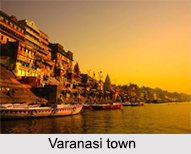 Ruins of Lat Bhairo are located in Varanasi at the junction of the Ghazipur road. It is seen to the north of the Raj Ghat road. There is a large square tank and the ruin scan be seen on its left bank. Lat Bhairo or the pillar is only a few feet high. It has been covered with copper sheeting. The original stone column of which the pillar has been made was about forty feet high. The pillar is just a small fragment of the stone column. It was earlier covered with ancient carvings, which are thought to be inscriptions. Once during a terrible conflict with the Hindus the Muslims threw down the pillar. Later it was destroyed by fire that soon caused it to crumble into pieces.
Ruins of Lat Bhairo are located in Varanasi at the junction of the Ghazipur road. It is seen to the north of the Raj Ghat road. There is a large square tank and the ruin scan be seen on its left bank. Lat Bhairo or the pillar is only a few feet high. It has been covered with copper sheeting. The original stone column of which the pillar has been made was about forty feet high. The pillar is just a small fragment of the stone column. It was earlier covered with ancient carvings, which are thought to be inscriptions. Once during a terrible conflict with the Hindus the Muslims threw down the pillar. Later it was destroyed by fire that soon caused it to crumble into pieces.
The Lat Bhairo once stood in the vicinity of a courtyard of a temple. However, later the temple was destroyed by the Mughal ruler Aurungzeb. On its site a mosque was erected. A close look at the pillar reveals the fact that upper portion had been thrown down. The ancient level of the ground was some six or eight feet lower than what it appears to be now. The pillars of the temple had been carved beautifully. Some of the carvings are still well preserved. There are several pillars embedded in the brickwork. There is a Muslim cemetery below the upper terrace on which the lat stands. The cemetery has a Rauza, or tomb, in the middle.
The building is supported by sixteen pillars. Each of these pillars is eight feet two inches in height. They also have architraves, between their capitals. These are one foot two inches in thickness. In the southern direction there are five pillars in the verandah. Some of these pillars have been adorned with scroll work and the lotus plant. The four corners of the pillars have been deeply carved with images of lotus seed-pod. The pillar has been crowned with a round stone, projecting two inches.
This article is a stub. You can enrich by adding more information to it. Send your Write Up to content@indianetzone.com



















